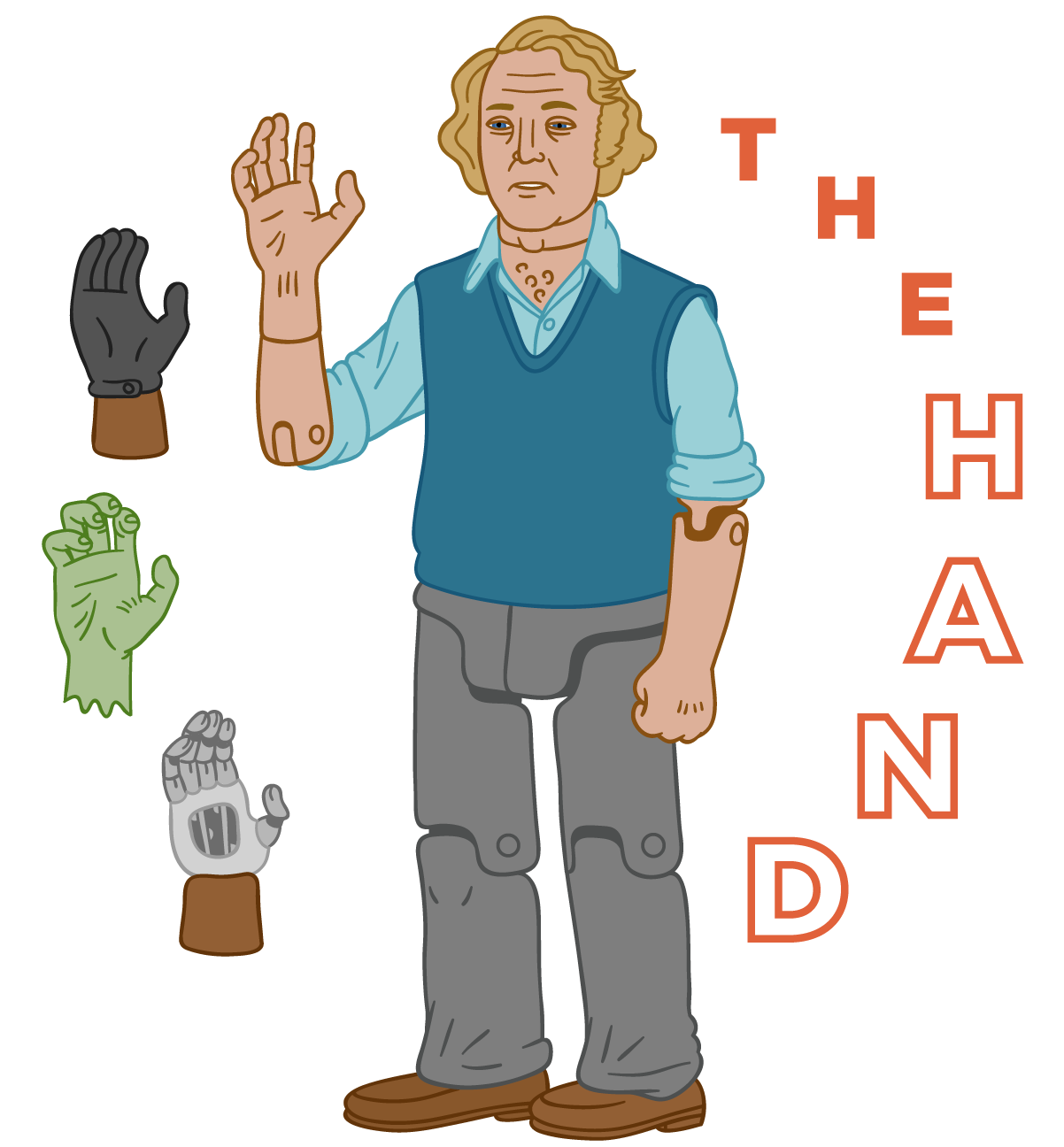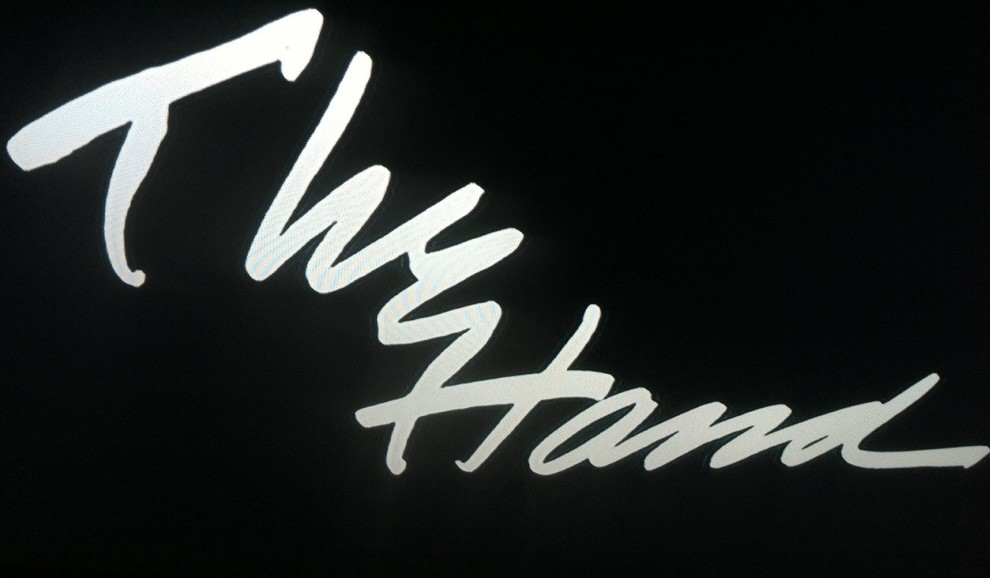The October Diaries: The Hand
 Â
Â
Illustration by Max Brown
Blurbs by Sean & Christof
Â
Â
Illustration by Max Brown
Blurbs by Sean & Christof—
October 20th, 2014:
The Hand
Year: 1981
Director: Oliver Stone
Format:Â DVD
From IMDB:Â Jon Lansdale is a comic book artist who loses his right hand in a car accident. The hand was not found at the scene of the accident, but it soon returns by itself to follow Jon around, and murder those who anger him.
Tagline: “It lives. It crawls. And suddenly, it kills.”
Sean’s Take:
Michael Caine deserves a horror Oscar for his performance in The Hand. It was a rare delight getting to see an acting heavyweight partake in a fringe movie like this and he appears to give it his all.* He refused to belittle the material, no matter how slight it might’ve been, committing himself seriously to a movie that often ended up in some very silly places.
The titular appendage belonged to Caine before being detached, and set free, in a terrifying car accident. It was during this bloody collision when I fully understood what kind of movie I was in for. Going in, I didn’t know anything about it, except Caine’s presence as the lead and that it was an early Oliver Stone oddity. After seeing such a horrible sight so early, and seeing him lose his hand, my hopes and suspicions were confirmed. We were really going to see a killer hand movie.
Stone and Caine did a fantastic job setting up Caine’s character as an illustrator, so when the hand is severed you immediately realize the tragedy of the loss is compounded by his everyday reliance on the appendage in order to pursue his livelihood. This was also when I started thinking about how the movie must be feeling more like a gut-punch for Max (illustrator of this month’s series). I imagined he must be feeling a  specialized sort of anxiety (a feeling he later confirmed having). It would be like if a professional soccer player watched a movie about a professional soccer player losing his foot in a tractor accident, or a peeping tom watching a movie about a peeping tom who goes blind.
Unfortunately, the kill shots weren’t that great. I suppose this is the price you pay when you make a single detached hand your principal antagonist. It’s a villain without infinite potential, it’s just a hand. We got a few goofy strangles, but not much else. The Michael Caine vs. MIchael Caine’s Detached Hand battle near the end was a lot of fun though, and the initial accident where Caine loses the hand provided enough horror to linger over the rest of the movie.
The Hand lands in the top half of October’s viewings and if its kills were something to write home about, and there was a bit more propulsion to the action, it could’ve made a run for one of the tip-top spots.
*According to the internet, Michael Caine said in an interview that the only reason he did this film was to get enough money to build a new garage on his house. This blatant cash-grab did not lessen his commitment.Â
Christof’s Take:
This movie seems to be the much more dour fore-father to the comedy-horror film, Idle Hands. That’s right. We’ve got a killer hand on the loose! Or do we? Probably! Maybe?
Doesn’t matter. I’m not gonna talk about that too much. I’m boring, so I talk about symbolism.
Michael Caine, who brings a little extra performative intensity and class to the month, plays Jon Lansdale, husband, father, and comic strip artist. One morning, he and his daughter see a moving lizard’s tale (the movie is adapted from a novel titled, The Lizard’s Tail). His daughter says, “It’s alive.†Jon replies, “It’s just a reflex.â€
Then black cat picks up the writhing lizard’s tail with its mouth and runs off with it. And in spite of this good omen, old Jonny has some poor luck this day.
[Interpretation Spoiler Alert! For the rest of it!]
During a high-stress argument with his wife in the car that implies the marriage is not terribly stable and that Jon has anger/verbal abuse issues. In a fit of distraction and tension, there is a road accident in which Jon loses his hand. I will make the argument that the hand is a symbol for control. I don’t think it’s an accident that in the same scene he is shown to be losing his control over his marriage, he is shown losing his hand.
His semi-rotted hand that was snipped by a passing car was never found, and it starts to move around of its own accord. It is trying to reclaim the control that has been lost through violence. Because Jon has dreams/visions/memories/hallucinations of the hand’s actions, we don’t know if the hand is actually out there, and we’re left wondering if this is the result of a psychic link or a psychotic break down. In either case, the symbol has become ironic in his inability to control the symbol for control.
He is given a black-gloved mechanical hand to help ease his transition. But it has a fierce grip, one that he can only control so much. For instance, he cannot use it to This glove is both literally and figuratively dark and inhuman. Both the severed and prosthetic hands can be seen to represent his uncontrollable moods, the black-outs he has, and his overall troubled psyche, all of which are an extension of him, yet appear separate.
Now: why wouldn’t Jon want to lose control over his family? Well, he’s a man, and a literal patriarch at that. Us men are notorious for wanting to maintain control. Could this be an example of someone reading too much between the lines? Have a look at his work situation.
Jon, as a handless graphic artist (and therefore an impotent artist), has to work with someone else on his strip. Someone else is lending a hand (sorry / you’re welcome), but in doing so, he has altered the comic strip, guiding the character and story in different ways. Anne suggests he “give him upâ€, but Jon doesn’t want to give up Mandro.
Oh right, his comic strip character’s name is Mandro. It might be safe to assume this the character of Jon is concerned with male power.
Jon is furious with the altercations to his character, mainly the inclusion of thought bubbles featuring glimpses of introspection.
“You’ve weakened my character…. by making him look too deep inside himself. Mandro doesn’t think. You don’t cut the balls off Superman.â€
His patriarchal ideals and sense of control are both being nudged out of the picture. And the man who does not accept this seems to further lose himself to violence and emotional decay. To salvage his identity through revision was the solution to all of this mess from square one. He was given many opportunities to stake his claim on control by revising his own misogynistic mindset, but he is too stubborn to resist his own impulse to not think, to not look too deeply inside.
The hand, Mandro, and his entire male identity are all an extension of himself, much like the tail that is an extension of the lizard: operating out of thoughtless reflex.
